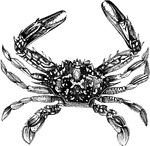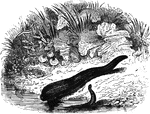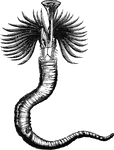
Serpula contortiplicata
"The Serpulae, which form irregularly twisted calcareous tubes, often grow together in large…
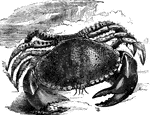
Common European crab
"These have the shell regularly rounded in front and narrowed behind; the legs are of moderate length,…

King crab
"It is among the largest of crustaceous animals, sometimes measuring as much as two feet in length.…
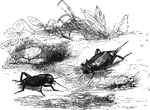
Field Cricket
"Another species of cricket is the Field-cricket, a timid animal which avoids the society of man, living…
!["Like that animal [the mole] it is constantly engaged in burrowing in the earth; and to enable it to do this with facility iits anterior limbs are converted into a pair of flat, fossorial organs, which are turned outward in exactly the same manner as the hand of the mole. In its pasage through the earth it does great injury to the roots of plants, but it said to live quite as much upon animal as vegetable food." — Goodrich, 1859](https://etc.usf.edu/clipart/14900/14935/molecricket_14935_mth.gif)
Mole Cricket
"Like that animal [the mole] it is constantly engaged in burrowing in the earth; and to enable it to…

Cyclops
"The best-known form of the Copepoda is the genus Cyclops, specimens of whch may be found in…
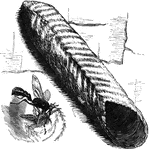
Dauber
"A South American genus, Pelopaeus, allied to the preceeding, is called the Dauber, from its…
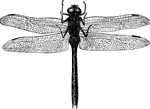
American Dragonfly
"They are often seen moving with a rapid flight over rivers, ponds, and meadows, alighting for a moment,…

Eleanor Dragonfly
"Among the larger kinds of dragon-fly is the Libellula depressa of Linnaeus, common in Europe,…
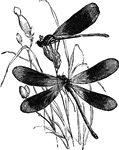
Virgin Dragonfly
"One of the most beautiful species of Euopean dragonflies is the Virgin Dragon-fly, Libellela virgo,…
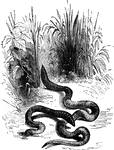
Earth-worms
"The bodies of these animals are of a cylindrical form, somewhat pointed at the anterior extremity,…

Earwigs
"The Foficulina includes the Earwig, Forficula, which appears to live principally upon vegetable…
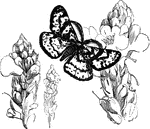
Fidonia Plumistaria
"The European Fidonia Plumistaria, is distinguised by its curious feathery antennae." —…

Flea
"Aphaniptera includes the fleas, which, despite their minuteness, have made themselves a name in the…
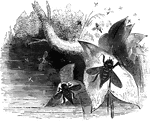
Flies
"In these the head is generally of considerable size, and is furnished with a pair of large, compressed…

Boat Fly
"They carry the air required for their respiration in a space left for this purpose between the wings…
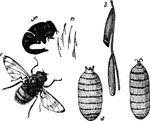
Breeze Fly
"a, eggs of the Breeze-fly; b, the same magnified; c, larva, or bot; d, chrysalis; e, perfect insect;…
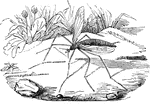
Crane Fly
"The tipulidae have the proboscis short, terminated by a pair of fleshy lips, inclosing two bristles."…
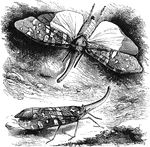
Lantern Fly
"The family of Fulgorina includes the Lantern-flies, of which a large species inhabiting…
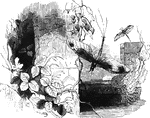
May Fly
"These insects are called Day-flies from the shortness of their existence in the perfect state;…
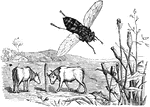
Ox Fly
"The Ox-fly, Oestrus bovis, is three-forths of an inch long, and lays its eggs in the skin of young…

Spanish Fly
"These insects are common in the South of Europe, and are especially abundant in Spain, where they are…
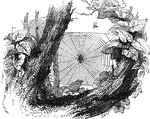
Garden-spiders
"Some, of which the Common Garden Spider, Epeira diadema is an excellent example, construct…
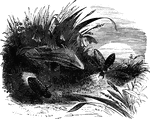
Glowworm
"The female is chiefly luminous. It is a flat, grayish-brown creature, rather more than half an inch…
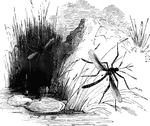
Gnats
"In the family Culicidae, or Gnats, which include several pre-eminently bloodthirsty species,…

Carolina Grasshopper
"The Carolina Grasshopper, Gryllus Carolina, is a large species with brown wings, common in…
!["[The paguridae] includes the Hermit or Soldier Crab, <em>Pagurus Bernardus</em>, the abdominal portion of whose body is quite soft, forming a sort of cylindrical fleshy mass behind the shelly cephalothorax. As the comfort of the animal would be materially interfered with were this soft, worm-like appendage exposed to be grabbed at by every passing fish who might take a fancy to it, he usually seeks some shelter for its tail, and the habitation selected is generally the empty shell of some univalve mollusk." — Goodrich, 1859](https://etc.usf.edu/clipart/14900/14983/hermit-crab_14983_mth.gif)
Hermit-crab
"[The paguridae] includes the Hermit or Soldier Crab, Pagurus Bernardus, the abdominal portion…
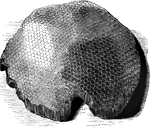
honey-comb
"The comb is made of wax, found in various plants, but which is also secreted by the bees themselves…

Hornets and Nest
"The Hornets resemble the Wasps in their habits, but but they are noted for their spitefulness and the…
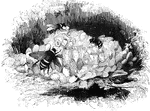
Interior of the Humble-Bee's Nest
"The Humble-bees, or as they are often called in this country, the Bumble-bees are…
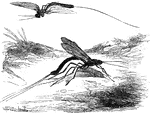
Ichneumon
"The ichineumons, with long ovipositors, as the European species, Ichneumon manifestator, seek…

External Anatomy of an Insect Skeleton
"Anatomy of the external skeleton of an insect" — Goodrich, 1859
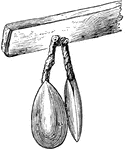
Modern Lingula
Lingula is a genus of brachiopods within the class Lingulata. Lingula is among the few brachiopods surviving…

Lob-worm
"Errantia means wandering, and is applied to numerous species, of which the Lob-worm or Lug-worm,…
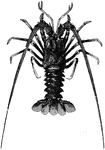
Spiny lobster
"The Spiny Lobster, Palinurus vulgaris, which may be taken as the type of the family, often…
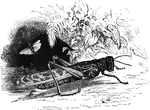
Locusta Cristata
"The migratory locust measures about two and a half inches in length, and some other exotic species…

Locusts
"Locusts, which, from their often collecting in vast swarms, and moving onward with a steady and irresistable…
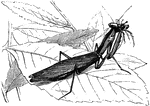
Praying Mantis
"The Mantis is one of the most voracious of its class, and only assumes this solemn and devout appearance…

Mealworm
"Tenebrio Molitor. Commonly known as the mealworm or the mealworm beetle. Common in Europe and in this…
Terebella medusa
"Distinguished by their habit of forming a tube or case, within which the soft parts of the animal can…
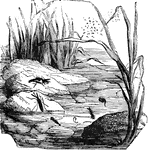
Mosquitos
"The Mosquitos, Colex musquito, which are very nearly allied to the gnats, are still greater…

Cecropia Moth
"The Cecropia Moth, A. Cecropia, is of a dusky reddish-brown; the wings expand six inches,…

Death's Head Moth
"The most remarkable species is the Death's Head Moth, Acherontia Atropos, a large kind,…
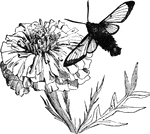
Hummingbird Moth
"A considerable number of insects belonging to Sphingina have transparents wings. Among them is the…
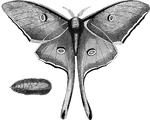
Luna Moth
"Among the larger and more splendid moths of our own country is the Luna Moth, or Green Emperor Moth,…

Caterpillar of the Luna Moth
"Among the larger and more splendid moths of our own country is the Luna Moth, or Green Emperor Moth,…

Chrysalis of the Luna Moth
"Among the larger and more splendid moths of our own country is the Luna Moth, or Green Emperor Moth,…

Mygale
"The spiders with which we in temperate climates are most acquainted are of small size, but in hot regions…
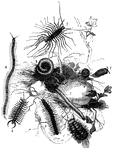
Myriapoda
"1 and 1, Egg and Larva of Iulus; 2, and 2, Iulus; 3, Polydesmus; 4, Glomeris; 5, Geophilus; 6, Lithobius;…
Nais
"In their form they resemble the common earth-worm; but their bodies are furnished, besides the ventral…
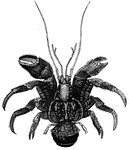
Purse-crab
"The Purse Crab, Birgus Latro is a very curious species found in Amboyna and some of the adjacent…
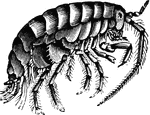
Sand-hopper
"The Common Sand-hopper, Talitrus locusta, which may be met with in thousands upon thousands…
